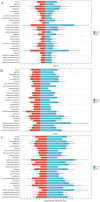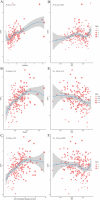The Evolving Global Burden of Young-Onset Parkinson's Disease (1990-2021): Regional, Gender, and Age Disparities in the Context of Rising Incidence and Declining Mortality
- PMID: 40619986
- PMCID: PMC12230373
- DOI: 10.1002/brb3.70659
The Evolving Global Burden of Young-Onset Parkinson's Disease (1990-2021): Regional, Gender, and Age Disparities in the Context of Rising Incidence and Declining Mortality
Abstract
Background: Young-onset Parkinson's disease (YOPD) has emerged as a significant global public health challenge characterized by its early onset among individuals in their prime working years, complex disruptions to social roles, and a substantial socioeconomic burden encompassing diminished productivity, escalating healthcare costs, and markedly reduced quality of life.
Methods: Using Global Burden of Disease (GBD) 2021 data, this study analyzed YOPD burden (ages 20-49) from 1990 to 2021, assessing age-standardized incidence rate (ASIR), mortality rate (ASMR), disability-adjusted life years rate (ASDR), and trends via Bayesian Age-Period Cohort (BAPC) modeling.
Results: Over the past three decades, the ASIR (estimated annual percentage change [EAPC] = 1.40%) and ASDR (EAPC = 0.14%) have significantly increased globally in YOPD, whereas the ASMR (EAPC = -0.42%) has declined. The sociodemographic index (SDI) exhibits an inverted U-shaped correlation with the burden of disease, with the middle SDI region representing the core burden zone globally. The rising trend in burden of disease is most pronounced in the middle SDI, and the high-middle SDI has the most significant upward trend in disease burden. Notably, East, South, and Southeast Asia accounted for more than 60% of global cases and deaths, led by China and India. Additionally, the burden of YOPD increases with age, with the number of new YOPD cases, deaths, and disability-adjusted life years (DALYs) being 48%, 92%, and 73% higher in men than in women, respectively. By 2050, the ASIR is projected to rise by 12.39%, whereas the ASMR and ASDR may drop by 23.75% and by 22.05%, reflecting a "rising incidence paired with declining mortality and projected reductions in disability burden" trend.
Conclusion: YOPD disproportionately impacts working-age populations, with geographic, gender, and age disparities. This analysis establishes YOPD as a priority condition for global neurological health initiatives, particularly in middle SDI regions and Asia, requiring differentiated regional approaches to mitigate its growing impact on working-age populations.
Keywords: age‐standardized rate; estimated annual percentage change; global burden of disease; socio‐demographic index; young‐onset Parkinson's disease.
© 2025 The Author(s). Brain and Behavior published by Wiley Periodicals LLC.
Conflict of interest statement
The authors declare no conflicts of interest.
Figures






Similar articles
-
Global, regional, and national burden of maternal disorders, 1990-2021: a systematic analysis from the global burden of disease study 2021.BMC Public Health. 2025 Jul 29;25(1):2576. doi: 10.1186/s12889-025-23814-w. BMC Public Health. 2025. PMID: 40730990 Free PMC article.
-
Mapping the global burden of early-onset Parkinson's disease: socioeconomic and regional inequalities from the Global Burden of Disease Study 2021.Front Public Health. 2025 Jul 22;13:1618533. doi: 10.3389/fpubh.2025.1618533. eCollection 2025. Front Public Health. 2025. PMID: 40766033 Free PMC article.
-
Burden of knee osteoarthritis in China and globally: 1990-2045.BMC Musculoskelet Disord. 2025 Jul 1;26(1):582. doi: 10.1186/s12891-025-08858-8. BMC Musculoskelet Disord. 2025. PMID: 40598022 Free PMC article.
-
National and subnational burden of brain and central nervous system cancers in China and global from 1990 to 2021: results from the global burden of disease study 2021.Arch Public Health. 2025 Jul 28;83(1):195. doi: 10.1186/s13690-025-01683-4. Arch Public Health. 2025. PMID: 40722045 Free PMC article.
-
Global burden and risk factors of musculoskeletal disorders among adolescents and young adults in 204 countries and territories, 1990-2019.Autoimmun Rev. 2023 Aug;22(8):103361. doi: 10.1016/j.autrev.2023.103361. Epub 2023 May 23. Autoimmun Rev. 2023. PMID: 37230312 Review.
References
-
- Andrews, S. V. , Kukkle P. L., Menon R., et al. 2024. “The Genetic Drivers of Juvenile, Young, and Early‐Onset Parkinson's Disease in India.” Movement Disorders: Official Journal of the Movement Disorder Society 39, no. 2: 339–349. - PubMed
-
- Aravindan, A. , Newell M. E., and Halden R. U.. 2024. “Literature Review and Meta‐Analysis of Environmental Toxins Associated With Increased Risk of Parkinson's Disease.” Science of the Total Environment 931: 172838. - PubMed
-
- Bloem, B. R. , Okun M. S., and Klein C.. 2021. “Parkinson's Disease.” Lancet (London, England) 397, no. 10291: 2284–2303. - PubMed
MeSH terms
Grants and funding
LinkOut - more resources
Full Text Sources
Medical
Miscellaneous

